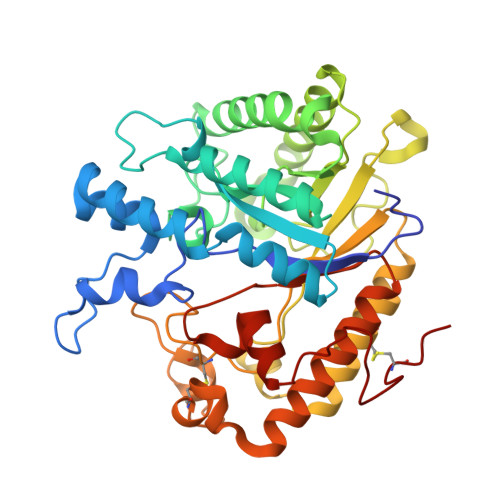Major Change in Regiospecificity for the Exo-1,3-beta-glucanase from Candida albicans following Its Conversion to a Glycosynthase.
Nakatani, Y., Larsen, D.S., Cutfield, S.M., Cutfield, J.F.(2014) Biochemistry 53: 3318-3326
- PubMed: 24804868
- DOI: https://doi.org/10.1021/bi500239m
- Primary Citation of Related Structures:
4M80, 4M81, 4M82 - PubMed Abstract:
The exo-1,3-β-glucanase (Exg) from Candida albicans is involved in cell wall β-d-glucan metabolism and morphogenesis through its hydrolase and transglycosidase activities. Previous work has shown that both these activities strongly favor β-1,3-linkages. The E292S Exg variant displayed modest glycosynthase activity using α-d-glucopyranosyl fluoride (α-GlcF) as the donor and pNP-β-d-glucopyranoside (pNPGlc) as the acceptor but surprisingly showed a marked preference for synthesizing β-1,6-linked over β-1,3- and β-1,4-linked disaccharide products. With pNPXyl as the acceptor, the preference became β-1,4 over β-1,3. The crystal structure of the glycosynthase bound to both of its substrates, α-GlcF and pNPGlc, is the first such ternary complex structure to be determined. The results revealed that the donor bound in the -1 subsite, as expected, while the acceptor was oriented in the +1 subsite to facilitate β-1,6-linkage, thereby supporting the results from solution studies. A second crystal structure containing the major product of glycosynthesis, pNP-gentiobiose, showed that the -1 subsite allows another docking position for the terminal sugar; i.e., one position is set up for catalysis, whereas the other is an intermediate stage prior to the displacement of water from the active site by the incoming sugar hydroxyls. The +1 subsite, an aromatic "clamp", permits several different sugar positions and orientations, including a 180° flip that explains the observed variable regiospecificity. The p-nitrophenyl group on the acceptor most likely influences the unexpectedly observed β-1,6-specificity through its interaction with F229. These results demonstrate that tailoring the specificity of a particular glycosynthase depends not only on the chemical structure of the acceptor but also on understanding the structural basis of the promiscuity of the native enzyme.
Organizational Affiliation:
Biochemistry Department, University of Otago , P.O. Box 56, Dunedin 9054, New Zealand.














